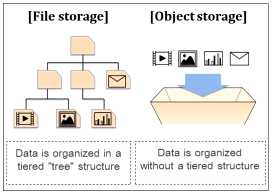FujiFilm Object Archive Software
Enables management of petabyte data, combining LTO with object storage for safe and cost-effective, long-term data protection.
This is a Press Release edited by StorageNewsletter.com on May 25, 2020 at 2:36 pmFujiFilm Recording Media USA., Inc. announced its Object Archive software.
It is designed to enable object storage technology for tape-based storage systems, including petabyte-class [i] data operations. By bringing object storage to tape, data centers can improve search, scalability, security and their calculated TCO beyond that offered by file-based storage solutions while meeting the increasing demand for storage.
The steady advancement of IoT, the proliferation of AI-based big data analytics, and new regulations such as GDPR all require long-term data conservation, and continue to increase the storage needs of organizations. [ii] Currently, over 80% of data is cold data – older and not accessed frequently, but still highly valuable or potentially valuable in the future. [iii] Maintaining and protecting this data over the long term is important for data-heavy organizations.
Today, many storage systems use a ‘file storage’ approach, which involves a hierarchical tree structure. Data processing time in a file storage environment typically increases along with increasing data volume. By contrast, the object storage approach does not use a tiered file structure, enabling the expansion of data capacity while maintaining performance and processing speed. Metadata [iv] can also be added to stored objects to facilitate fast and accurate data searches. As the cloud increasingly adopts object-based models, the object storage market is expected to grow annually by about 30% worldwide. [v]
The Object Archive software enables object storage on magnetic tape thanks to company’s developed open source file format, OTFormatSM, designed for object data. Tape technology is generally considered a low-cost solution to long-term storage of petabyte-class data especially because of the high-cartridge capacity, scalability, and low energy consumption of tape systems. Storing data on tape enables an ‘air gap’ – off-line/off-site storage considered to minimize the risk of cyberattacks – thereby adding a level of security.
The software also offers a S3-compatible API [vi] which is adopted in object storage, so that tape storage can be integrated with HDD drive and SSD systems, as well as cloud storage, to optimize tiered storage. It facilitates object storage based on data attributes and user needs, giving users the opportunity to store shared data on a network in the cloud while storing confidential, large-capacity cold data on tape.
The Object Archive software gives new and existing tape storage users the ability to build low-cost storage systems that excel in security, cost and performance. As a leader in the manufacturing of tapes and other solutions for storage,[vii] the company will continue to develop and provide performance, quality media and services to help protect and preserve the valuable data of its customers and the precious information of society.
[i] 1PB= 1,000,000GB
[ii] Source: IDC Data Age 2025: The digitization of the world from edge to core. November, 2018.
[iii] Source: LTO.org Hot, Cool and Cold Data. July, 2016
[iv] Accompanying information showing data attributes such as the date, time and location of data creation, person who created the data and keywords associated to the data.
[v] Source: IDC, Worldwide File- and Object-Based Storage Forecast, 2019-2023, December, 2019.
[vi] The interface format to facilitate data communications with Amazon’s cloud storage service, ‘Amazon SE.’ API stands for Application Programming Interface. Fujifilm Object Archive uses the S3 Glacier-compatible API when reading data. S3 is a trademark of Amazon.com, Inc.
[vii] Manufacturer share, according to Fujifilm.















 Subscribe to our free daily newsletter
Subscribe to our free daily newsletter

